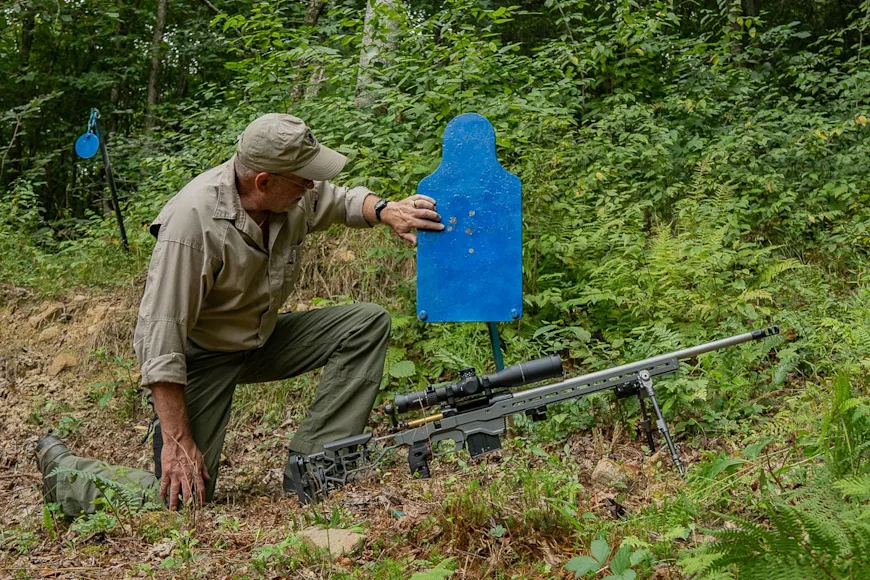It wasn’t that long ago that shooting 300 yards and beyond was considered “long range.” With the rifles, ammunition, optics, and accessories we have today, shooting out to 500 yards is not that complicated. In many cases, these hits can be easily obtained by simply working off a ballistic, MIL, or MOA style reticle. And quite often, even harsh winds can be compensated for by simply favoring the left or right edge of the target. A full value 10-mph wind at 500 yards will only push a bullet about a foot, which is a fairly easy visual/reticle correction. At 1,000 yards, that same wind will push the bullet five times as far.
Shooting Out to 500 Yards vs. 1,000 Yards
Consistently hitting at 1,000 yards is a different animal all together. At 500 yards, you’ll only be dealing with about five feet of drop. A reasonably good shooter can just eyeball that. At 1,000 yards you’re looking at maybe as much at 30 feet of drop, and an additional full-second of flight time. It’s nearly impossible to estimate 30 feet at 1,000 yards and an additional full second of flight is a long time for winds to affect the flight path of a bullet.
If 1,000 yards is the championship game, shooting out to 500 yards is the practice field and playoffs. It is where you develop the skills you need to make the 1,000-yards shots. It’s where you learn to make wind calls and apply the correct adjustments. And, just as importantly, it’s where you refine your DOPE and your drop chart. Just because your ballistic calculator calls for a 10.5 MOA correction at 500 yards does not mean that is exactly what’s needed. Ballistic solutions are approximations and not every riflescope will deliver exactly 0.25 MOA clicks. All of this will become apparent as you begin to stretch the distance past 300 yards.
Refining Technique
Working to shooting out to 500 yards is where you make sure you’re doing everything correctly. It’s where you refine your position so that it’s optimized. It’s where you experiment with wind estimation. It’s where you learn to apply shooting solutions based on the distance and environmental conditions. And it’s where you develop the confidence to know when you’re shooting at 1,000 yards you’ve done all these things correctly.
10-Step Pre-Shot Routine
Shooting out to 500 yards is best done with a standardized shot process that starts with establishing the current environmental conditions and consulting your DOPE. Step by step, here’s an example of a standardized shot sequence.
Establish the correct prone—natural point of aim—position behind the rifle.
Range the target and apply the correction to the elevation adjustment dial.
Make a wind reading and apply the correction to the windage adjustment dial.
Control your breathing.
Concentrate on the reticle.
Reevaluate the wind. If necessary, adjust with reticle hold off.
Control your breathing and concentrate on the reticle.
Wait for the natural respiratory pause.
Press the trigger.
Follow through by holding the trigger to the rear and watching for impact.
Making Corrections
If you get the hit, smile, cycle the bolt, and repeat. If you miss, you’ll need to craft a solution based on what you saw. This is often best accomplished by altering your original firing solution with a reticle correction. For example, if your bullet struck 2 MOA left and 1 MOA below target center, adjust your hold with the reticle by applying a 2 MOA shift to the right and a 1 MOA shift up. However, always, before attempting a second shot, take a moment to conduct another wind read; wind has a way of changing direction and speed at a moment’s notice.
Double-Check Ammo
When working inside 500 yards, it’s also a good time to conduct further ammunition evaluation. Just because a certain load performed well at 100 yards, does not mean it will perform the same when shooting out to 500 yards. This is also where you develop the competency with your rifle, riflescope, position, and the operation and understanding of your ballistics program. Before attempting shots beyond 500 yards, work to establish the DOPE in a minimum of 100-yard increments out to 500 yards. Don’t get it close, perfect it. If you cannot confirm your rifle is doing what your ballistics program predicts out to 500 yards, hits at 1,000 yards will be nothing but luck. And that’s what we’re going next—stretching the distance to a half-mile and beyond.






